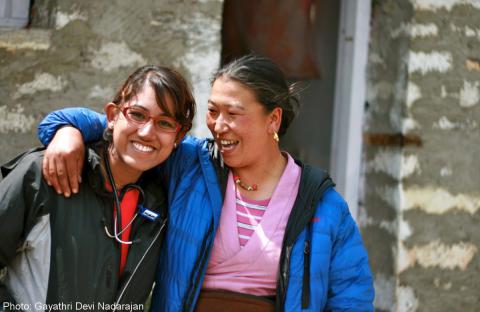The walk from the Kathmandu airport to the small Nepalese village of Phortse was a seven-day arduous trek.
Add 100kg worth of medical supplies and personal belongings to the mix and you would have a seemingly insurmountable task.
Yet Dr Gayathri Devi Nadarajan accomplished the feat with the help of Nepalese porters at the airport who helped to carry the equipment.
The 29-year-old emergency medical resident with SingHealth, who is attached to Singapore General Hospital, said: “They were amazing as they carried (equipment which amounted to) two to three times their bodyweight.”
Dr Gayathri headed to Phortse and two other villages in May 2012 to provide basic medical care to the people there. It was a trip she had been envisioning since she was a medical student.
She said: “I’ve always wanted to do medical work in the rural area, so when Kumaran (her then-boyfriend, who is now her husband) said he wanted to climb Mount Everest, I saw the opportunity for me to help out there.”
Before the trip, Dr Gayathri’s husband, Dr Kumaran Rasappan, 29, also a doctor, went on several practice climbs in Nepal. During these climbs, he visited the villages there and realised there was a need for better medical facilities and infrastructure. There was one main hospital in the region, but it was a four-hour walk from other villages.
Several villages had a small satellite hospital post, but these were basic and dilapidated.
In Phortse, there was just one room with an examination bed and a tap that did not provide running water.
Noting down what was needed, Dr Gayathri and her husband approached various organisations, family and friends to get the necessary equipment.
One of them was foldable stretchers. The version the Nepalese used comprised two bamboo poles and a piece of cloth in between, which made carrying it in the mountains a tough job. To tackle the problem, Dr Gayathri sought sponsorship for foldable stretchers that were portable and light.
When everything was ready, the couple headed to Nepal in May 2012 for a two-month trip.
Health education
Hoping to do something that could be maintained after they left, Dr Gayathri also made an effort to carry out health education. She recounted: “More than just treatment, I taught them basic hygiene, child hygiene and nutrition as well as maternal healthcare. I also trained the nurses.”
Before her arrival, the nurses treated illnesses mostly with Panadol. Dr Gayathri explained to them how to treat the different illnesses and also brought other types of basic medication like antibiotics.
Dr Gayathri and her husband are now looking to bring a larger team and a wider set of skills to Nepal next year.
She said: “Many other doctors have expressed interest, so for the next trip, maybe we can bring more equipment and a wider skill set. That way we can offer more aid, for example, eye screening.
“Health education is universal. Education is the most power tool we can utilise to create change that is sustainable.”
Source: The New Paper
